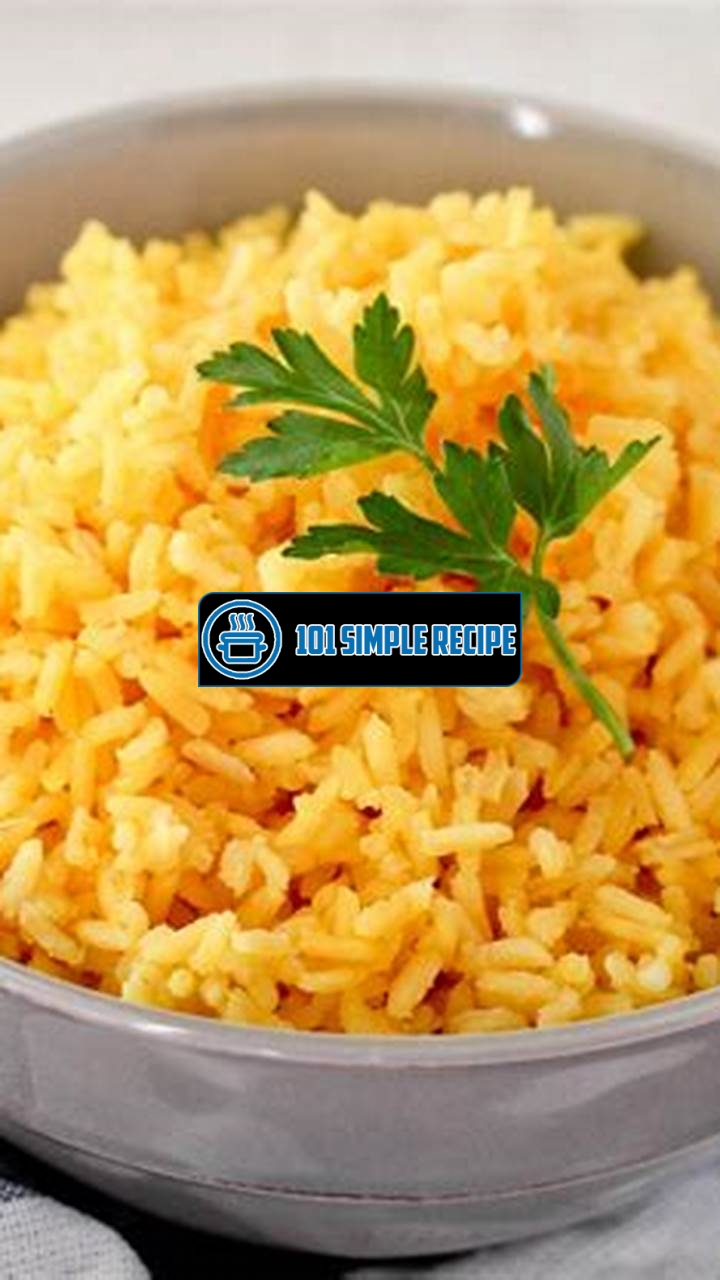Are you craving for a tasty and flavorful side dish to complement your main course? Look no further as we bring you an easy and delicious recipe for Yellow Rice! This vibrant and aromatic dish will not only add a pop of color to your plate but will also tantalize your taste buds with its blend of spices and herbs. Whether you are cooking for a family dinner or hosting a party, this yellow rice recipe is a surefire way to impress your guests. Plus, with our simple step-by-step instructions, you’ll have a mouthwatering batch of yellow rice ready in no time. So let’s get started and dive into the irresistible world of yellow rice! ✨

Understanding Yellow Rice
Yellow rice is a beloved dish that is cherished in many different cultures around the world. Its vibrant yellow color and rich flavor make it a favorite among both young and old. In this section, we will explore the origins of yellow rice and delve into its cultural significance. By understanding the history and variations of this delectable dish, you will gain a deeper appreciation for its widespread popularity.
The History of Yellow Rice
The history of yellow rice dates back centuries and can be traced to various regions. While it is challenging to pinpoint its exact origins, many believe it originated in South Asia. The use of turmeric, a key ingredient responsible for the rice’s golden hue, suggests a connection to Indian cuisine.
As explorers set sail and trade routes expanded, yellow rice traveled across continents, making its way to different cultures and cuisines. It became a staple in many countries such as Spain, Portugal, and the Caribbean, where it was embraced and adapted with local ingredients and flavors.
Throughout history, yellow rice has been a symbol of wealth and prosperity due to its vibrant color. It was often served during festive occasions and special celebrations, adding a touch of elegance to the dining table.
Variations of Yellow Rice
Yellow rice comes in various forms and is prepared in unique ways in different parts of the world. Each region puts its own spin on the dish, incorporating local ingredients and culinary techniques to create delightful variations.
In Latin America, yellow rice, also known as arroz amarillo, is commonly made by sautéing rice with onions, garlic, and annatto seeds. This gives the rice a beautiful yellow tint and a slightly nutty flavor. It is often served alongside beans, meats, or vegetables.
In Southeast Asia, yellow rice, or nasi kuning, is a popular dish that is typically served during special occasions or festivals. It is made by cooking rice with coconut milk, turmeric, and various spices. The result is a fragrant and aromatic rice that pairs perfectly with spicy dishes.
The Caribbean region has its own delectable version of yellow rice called arroz con gandules. This flavorful rice dish is made by cooking rice with pigeon peas, sofrito, and a variety of spices. It is a staple in many Caribbean households and is often served with savory meats and stews.
The Cultural Significance of Yellow Rice
Yellow rice holds deep cultural significance in many countries. It is more than just a delicious dish; it is a representation of tradition, community, and celebration.
In some cultures, yellow rice is served during religious ceremonies or festivals as an offering to the gods or ancestors. It is believed to bring good luck and blessings to those who partake in it. The vibrant color of the rice symbolizes joy, abundance, and prosperity.
Furthermore, yellow rice has the power to bring people together. It is often shared among family and friends during gatherings, creating a sense of unity and togetherness. The act of preparing and serving yellow rice is a labor of love, showcasing the culinary skills and cultural heritage of the cook.
In conclusion, yellow rice is not just a simple side dish; it is a beloved culinary treasure that has traveled through time and across borders. Its rich history, tantalizing variations, and cultural significance make it a dish worth savoring and celebrating. So, the next time you enjoy a plate of yellow rice, remember the diverse cultures and traditions it represents.
Yellow rice recipe is a delicious and flavorful side dish that pairs well with a variety of main courses.
Choosing the Right Rice
When it comes to preparing yellow rice, choosing the right rice variety is crucial for achieving a delicious and successful dish. Not all rice varieties are created equal, and each type has its own unique qualities that can greatly impact the taste and texture of your yellow rice. In this section, we will explore the best rice varieties to use when preparing this flavorful dish and why the right choice is important.
Basmati Rice: The Fragrant Option
If you are seeking a fragrant and aromatic yellow rice, look no further than basmati rice. Originating from India, basmati rice is known for its long, slender grains and distinctive fragrance. This variety of rice has a nutty flavor and a fluffy texture that pairs perfectly with the vibrant colors and flavors of yellow rice. Its aromatic qualities add an extra layer of complexity to the dish, making it a favorite choice among many home cooks and professional chefs alike.
Basmati rice is also an excellent option for those who enjoy pairing their yellow rice with various Indian curries and dishes. The fragrant and fluffy grains of basmati rice complement the rich and bold flavors of Indian cuisine, creating a harmonious balance in every bite.
Long Grain Rice: A Versatile Choice
Long grain rice is another popular option for making yellow rice, thanks to its versatility and ability to absorb flavors. This type of rice has longer and slimmer grains compared to medium or short grain varieties. Its elongated shape allows it to retain a firm and separate texture even after cooking, making it ideal for yellow rice dishes that require a light and fluffy outcome.
In addition to its appealing texture, long grain rice offers the advantage of being able to absorb the flavors and spices used in the preparation of yellow rice more effectively. The grains have a natural ability to soak up the vibrant colors and savory aromas, resulting in a more flavorful and visually appealing dish.
Jasmine Rice: Ideal for Asian-Inspired Recipes
For those who prefer a milder and slightly sweet taste in their yellow rice, jasmine rice is the perfect choice. This fragrant rice variety from Thailand has a naturally enticing aroma that resembles that of pandan leaves. When cooked, jasmine rice becomes soft, moist, and slightly sticky, which makes it a popular choice for Asian-inspired dishes.
Jasmine rice is a wonderful accompaniment to various Southeast Asian curries and stir-fry dishes. Its delicate flavor enhances the overall experience of enjoying yellow rice, as it doesn’t overpower the other ingredients but rather provides a subtle, yet pleasant taste.
Choosing the right rice variety is essential for preparing delicious and flavorful yellow rice. Whether you opt for the fragrant basmati rice, the versatile long grain rice, or the mild and slightly sweet jasmine rice, each option brings its own unique characteristics to the dish, ensuring a memorable and satisfying meal.
Key Ingredients for Flavor
When it comes to preparing a delicious yellow rice, the key lies in the selection of the right spices and ingredients. These are the essential elements that not only give the rice its characteristic golden color but also contribute to its delectable taste. Let’s explore the key ingredients that make yellow rice a flavorful culinary experience:
Turmeric: The Culinary Powerhouse
In the world of spices, turmeric is truly a powerhouse. Known for its vibrant yellow hue, this spice is the primary ingredient responsible for giving yellow rice its distinctive color. Apart from enhancing the appearance, turmeric also adds a warm and earthy flavor to the rice. Its subtle bitterness and peppery notes create a perfect balance of taste and aroma.
In addition to its culinary uses, turmeric also possesses numerous health benefits. It is a natural anti-inflammatory agent and is rich in antioxidants. Including turmeric in your yellow rice not only makes it delicious but also contributes to your well-being.
Saffron: The Luxurious Option
For those seeking a touch of luxury in their yellow rice, saffron is the go-to ingredient. Derived from the delicate threads of the Crocus sativus flower, saffron offers a rich and aromatic experience. Just a few strands of this exotic spice can transform an ordinary rice dish into a gourmet delight.
The distinct flavor profile of saffron adds a sweet and floral note to the yellow rice, elevating its taste to a whole new level. However, it’s important to use saffron judiciously as it can be quite potent. Soak the threads in warm milk or water before adding them to the rice to ensure maximum flavor infusion. Indulge in the opulence of saffron-infused yellow rice for a truly unforgettable culinary journey.
Onion, Garlic, and Other Aromatics
While turmeric and saffron provide the primary flavors and colors, it’s the combination of aromatics like onion and garlic that completes the taste profile of yellow rice. These ingredients bring a depth of flavor and tantalizing aroma that make each forkful of rice irresistible.
Finely chopped onions and minced garlic are typically sautéed in oil or butter before adding the rice. This process not only softens the onions and garlic but also releases their natural oils, intensifying their flavors. The resulting caramelization adds a subtle sweetness to the dish, creating a harmonious blend of savory and sweet. Other aromatic ingredients such as bay leaves, cloves, and cinnamon can also be included to enhance the overall taste experience.
So, the next time you embark on a culinary adventure to prepare yellow rice, remember to select these key ingredients that hold the secret to its rich flavor and beautiful golden hue. With the enticing combination of turmeric, saffron, onion, garlic, and other aromatics, you’ll create a dish that will captivate your taste buds and leave your guests craving for more. Enjoy the delightful experience of homemade yellow rice! ✨
If you’re interested in trying other types of rice dishes, you might enjoy this rice pudding recipe. It’s a creamy and comforting dessert that’s perfect for any occasion.
Preparing Yellow Rice
Learn step-by-step instructions on how to prepare yellow rice to perfection, ensuring each grain is packed with flavor.
Infusing the Rice with Aromatics
To infuse your yellow rice with aromatic flavors, start by rinsing the rice under cold water. This will remove any excess starch and prevent the rice from becoming sticky. Then, heat a tablespoon of vegetable oil in a large pot over medium heat and add in finely chopped onions and garlic. Sauté them until they become translucent and fragrant, which should take around 2-3 minutes.
Tip: Chopping the onions and garlic finely will help the flavors distribute more evenly throughout the rice.
Once the onions and garlic are cooked, it’s time to add the star ingredient: turmeric. Turmeric not only gives the rice its vibrant yellow color, but it also adds a mild earthy flavor. Sprinkle a generous amount of turmeric over the onions and garlic, making sure they are fully coated. Continue to cook for another minute to allow the flavors to meld together.
Adding the Spices and Seasonings
In addition to turmeric, other spices and seasonings can take your yellow rice to the next level. Common additions include cumin, paprika, and saffron. Add these spices to the pot and stir well to combine with the onion, garlic, and turmeric mixture.
️ Pro-tip: Experiment with different spices and seasonings to create your own unique flavor profile. Don’t be afraid to get creative in the kitchen!
Once the spices are well incorporated, it’s time to add the rice. Pour in the desired amount of rice and mix it well with the aromatic base. Make sure every grain is coated with the spice mixture. This step ensures that the flavor is evenly distributed throughout the rice.
Fun fact: Different types of rice may require slightly different cooking times. Check the package instructions or refer to a trusted cooking resource for specific cooking times.
Techniques for Achieving Perfectly Cooked Rice
Cooking rice to perfection can be a bit tricky, but with the right techniques, you can achieve fluffy and perfectly cooked yellow rice. Follow these steps:
- Use a ratio of 1:2 (1 cup of rice to 2 cups of water) to ensure the rice is cooked properly.
- Bring the mixture to a boil over medium-high heat, then reduce the heat to low, cover the pot, and let it simmer for about 15-20 minutes. Do not remove the lid during this time, as it will trap the steam and help the rice cook evenly.
- After 15-20 minutes, turn off the heat and let the rice sit, covered, for an additional 5 minutes. This allows the rice to absorb any remaining liquid and ensures a fluffy texture.
- Once the rice is cooked, fluff it with a fork to separate the grains.
Note: It’s important to adjust the cooking time and water ratio according to the specific type of rice you are using. Basmati rice, for example, may require less water and a shorter cooking time than other varieties.
Now you have mastered the art of preparing delicious yellow rice! The aromatic flavors, vibrant color, and fluffy texture will surely make it a crowd-pleaser. Enjoy your flavorful creation as a side dish or as the star of your meal!
Looking for more tasty recipes? Check out this rice recipes collection for inspiration.
Serving and Pairing Yellow Rice
When it comes to serving and pairing yellow rice, there are several delicious options that can elevate your meal to a whole new level. Yellow rice, with its vibrant color and fragrant aroma, is a versatile dish that can be paired with a variety of complementary dishes. Whether you prefer traditional accompaniments or creative fusion recipes, there is something for everyone. Read on to discover the best ways to serve and pair yellow rice for a satisfying and well-rounded meal.
Traditional Accompaniments for Yellow Rice
If you are a fan of classic flavors, there are some traditional accompaniments that perfectly complement the taste and texture of yellow rice. One popular option is to pair it with grilled or roasted chicken. The juicy and flavorful chicken adds a protein component to the meal, making it more filling and nutritious. Another traditional choice is to serve yellow rice alongside black beans. The combination of the savory rice and creamy beans creates a comforting and satisfying dish.
For those who enjoy a bit of heat, adding some spicy sausage to yellow rice can take the flavor to the next level. The smoky and spicy sausage balances out the mildness of the rice, creating a delicious and satisfying dish. And let’s not forget about the classic pairing of yellow rice and plantains. The sweet and caramelized plantains provide a delightful contrast to the savory rice, creating a unique and flavorful combination.
Variations and Fusion Recipes
If you’re looking to add a twist to your yellow rice, there are plenty of variations and fusion recipes to explore. One option is to incorporate vegetables into the dish. Adding mixed vegetables, such as peas, carrots, and corn, not only enhances the visual appeal but also boosts the nutritional value of the meal. You can also experiment with different spices and seasonings to create a unique flavor profile. For example, adding turmeric and cumin can give the yellow rice a distinctive taste and aroma.
For those who enjoy fusion cuisine, there are endless possibilities to explore. You can try pairing yellow rice with spicy shrimp for a delicious and satisfying seafood option. The combination of the tender shrimp and flavorful rice creates a mouthwatering dish. Another fusion idea is to serve yellow rice with grilled vegetables. The smoky charred flavor of the vegetables adds depth and complexity to the dish, making it a perfect choice for vegetarians.
Pairing Yellow Rice with Meat, Vegetables, and Seafood
Yellow rice is incredibly versatile when it comes to pairing with different proteins. Whether you prefer meat, vegetables, or seafood, there are countless options to suit your taste. If you’re a meat lover, consider serving yellow rice with succulent grilled steak or hearty braised pork. The richness of the meat complements the flavors of the rice, creating a hearty and satisfying meal.
For seafood enthusiasts, yellow rice can be paired with grilled fish or seafood stew. The delicate flavors of the seafood harmonize with the aromatic rice, creating a light and refreshing dish. And if you’re a fan of vegetables, don’t worry – yellow rice can be paired with a variety of roasted or sautéed vegetables. The combination of the vibrant colors and flavors of the vegetables with the yellow rice creates a visually stunning and delicious meal.
As you can see, yellow rice can be served and paired in numerous ways to create a satisfying and well-rounded meal. Whether you prefer traditional accompaniments, fusion recipes, or different proteins, there are endless options to explore. So go ahead and get creative in the kitchen – prepare delicious yellow rice and pair it with complementary dishes to elevate your dining experience.
Thank you for taking the time to read our article on the recipe of yellow rice. We hope you found it informative and inspiring. If you’re craving the vibrant flavors and enticing aroma of this delicious dish, be sure to visit our website again for more mouthwatering recipes. Experiment with different variations and share your culinary adventures with friends and family. Stay tuned for more exciting recipes and culinary adventures!
Frequently Asked Questions
Here are some frequently asked questions about the recipe of yellow rice:
| No. | Questions | Answers |
|---|---|---|
| 1. | What spices can I use for yellow rice? | You can use a combination of turmeric, cumin, and saffron to achieve that vibrant yellow color and unique flavor. |
| 2. | Can I substitute white rice with brown rice? | Yes, you can use brown rice instead of white rice, but note that the cooking time may vary. |
| 3. | What proteins can I add to yellow rice? | You can add chicken, shrimp, or even tofu to your yellow rice for a protein-packed meal. |
| 4. | Can I make yellow rice in a rice cooker? | Yes, you can make yellow rice in a rice cooker by simply adding the spices and ingredients to the cooker before starting the cooking process. |
| 5. | Is yellow rice gluten-free? | Yes, yellow rice is gluten-free, but be sure to check the ingredients of any accompanying sauces or add-ons for gluten content. |
| 6. | Can I freeze yellow rice? | Yes, you can freeze yellow rice in an airtight container for future use. Thaw it in the refrigerator overnight before reheating. |
Explore the Flavors of Yellow Rice
Yellow rice is a delightful dish that brings warmth and color to your dining table. With its unique blend of spices and aromatic fragrance, it’s sure to captivate your taste buds. Whether you’re a seasoned chef or a culinary enthusiast, trying out different recipes is a wonderful way to expand your culinary repertoire. So, don’t hesitate to embark on a flavorful adventure with yellow rice. Stay curious, embrace new flavors, and let the vibrant hues of this dish bring joy to your kitchen. Visit us again soon for more culinary inspirations and exciting recipes!
Jump to Recipe
Recipe of Yellow Rice

Learn how to make delicious yellow rice with this easy recipe. Perfectly seasoned with aromatic spices, it’s a versatile dish that pairs well with various cuisines.
- 2 cups long-grain rice
- 1 teaspoon turmeric
- 1 teaspoon cumin
- 1/2 teaspoon saffron threads
- 4 cups vegetable broth
- 1 tablespoon olive oil
- 1 small onion (diced)
- 2 cloves garlic (minced)
- Salt and pepper to taste
- In a large pot, heat the olive oil over medium heat. Add the onion and garlic, and sauté until translucent.
- Add the rice, turmeric, cumin, and saffron. Stir well to coat the rice with the spices.
- Pour in the vegetable broth and bring to a boil. Reduce heat to low, cover, and simmer for 20-25 minutes, or until the rice is tender.
- Remove from heat and let the rice sit, covered, for 5 minutes. Fluff the rice with a fork before serving.






